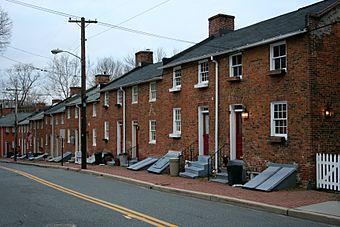Oella, Maryland facts for kids
Oella is a mill town on the Patapsco River in western Baltimore County, Maryland, United States, located between Catonsville and Ellicott City. It is a 19th-century village of millworkers' homes.
Contents
History
Oella was founded in 1808 by the Union Manufacturing Company as a working class community for the company's mill workers. It was one of the earliest and most extensive cotton factories in the United States and used water-powered looms as early as 1819.
The Union Manufacturing Company was motivated by the Embargo Act of 1807 which required Baltimore merchants to manufacture finished goods in the colonies rather than England. Stock in the company was issued to fund a series of industrial mills, the largest working with cotton and wool. Child and indigent labor was used reaching 150 employees in 1811. After the War of 1812 ended the embargo, cotton prices fell. A fire at the largest mill on 13 December 1815 took a decade to rebuild and recover from. The Mill rebounded with water driven looms, and expanded to three mill buildings before finally dissolving in 1887 after another drop in textile prices. William J. Dickey of Dickeysville (Gwynns Falls) purchased the mill in 1887, operating it as W.J. Dickey and Sons, naming the mill "Oella" after the first woman to spin cotton in America.
The Oella Historic District includes the village that consists of 19th century workers housing and one late 19th century church. The only known 20th century building is the W.J. Dickey Company Mill constructed in 1919 as a rebuild after a 1918 fire. The plant was eventually used for the city. A drawing from 1812 by Maximilian Godefroy shows most of the stone buildings. The brick houses date from the mid-19th century, while the frame buildings were constructed at the end of the century. The Oella Methodist Church is a simple frame building with a tower on the northeast corner, which has been converted into offices. The Patapsco River continued to provide power to generate electricity until 1972, when Hurricane Agnes flooded the power plant. That same year, the Dickey Company ceased manufacturing.
It was added to the National Register of Historic Places in 1976. Also listed on the National Register at Oella are the Ellicott's Mills Historic District and Mt. Gilboa Chapel.
Oella is along the route of the Trolley Line Number 9 Trail
Benjamin Banneker Historical Park and Museum
A park commemorating Benjamin Banneker is located in a stream valley woodland at the former site of Banneker's farm and residence at the eastern edge of the Oella community. The Baltimore County Department of Recreation and Parks manages the park, which was dedicated on June 9, 1998. The park, which encompasses 138 acres (56 ha) and contains archaeological sites and extensive nature trails, is the largest original African American historical site in the United States. The primary focus of the park is a museum highlighting Banneker's contributions. The museum contains a visitors center that features a collection of Banneker's works and artifacts, a community gallery, a gift shop and a patio garden.
The park contains an 1850s stone farmhouse, now named the "Molly Banneky House". The three-story house was restored as an office complex in 2004.
On November 12, 2009, officials opened a 224 square feet (20.8 m2) replica of Banneker's log cabin on the park grounds, reportedly two days before the 278th anniversary of Banneker's birth. Baltimore County's delegation to the Maryland General Assembly secured a $400,000 state bond for the design and construction of the cabin. The original estimated cost to construct the cabin in accordance with its drawings and specifications was $240,700.
A historical marker that the Maryland Historical Society erected to commemorate Banneker stands on the grounds of the park. The marker replaced the last of three earlier markers that vandals had previously destroyed.
Persons of note
- Benjamin Banneker (November 9, 1731 – October 9, 1806) was a free African American scientist, surveyor, almanac author and farmer. Born in Baltimore County to a free African American woman and a former slave, Banneker had little formal education and was largely self-taught. He is known for being part of a group led by Major Andrew Ellicott that surveyed the borders of the original District of Columbia, the federal capital district of the United States.
- Banneker's knowledge of astronomy helped him author a commercially successful series of almanacs. He corresponded with Thomas Jefferson, drafter of the United States Declaration of Independence, on the topics of slavery and racial equality. Abolitionists and advocates of racial equality promoted and praised his works.
Geology
Oella is the type locality of the Oella Formation, a Late Proterozoic or early Cambrian schist.
- Oella Historic District, Baltimore County, including undated photo, at Maryland Historical Trust
Notable person
- Benjamin Banneker: scientist, surveyor, almanac author and farmer.




